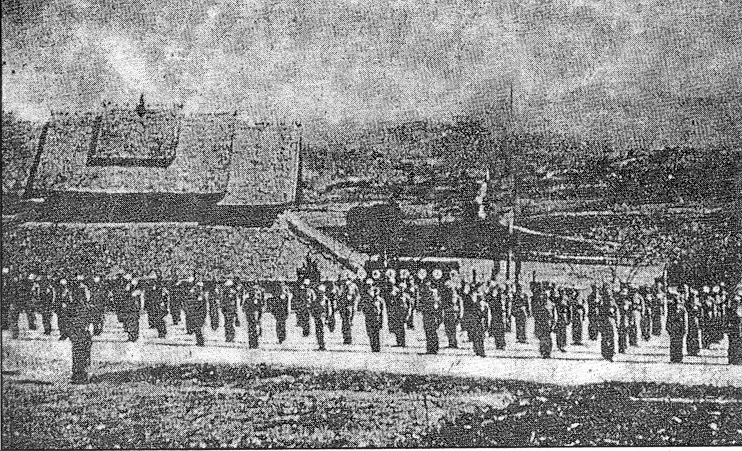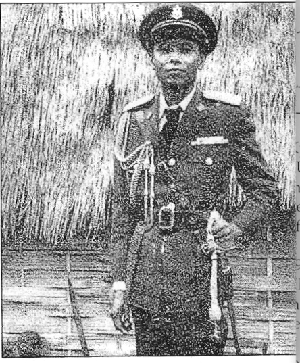The Kuomintang (KMT)Aggression
The
KMT presence inside Myanmar’s Shan State began from the Second World War.
In 1949-59 the KMT 8’th and 26’th armies and the 93’rd division, fleeing
from defeat by the PLA, entered Myanmar and occupied Myanmar territory along
the Kyaing Tong-Tachileik road up to the 80-mile mark.
 |
KMT invaders taking a military
base inside Myanmar territory
 |
KMT strengthened their lacal
people in such a coercive way
As the KMT
troops suffered more and more defeats they retreated into Myanmar and thus increased
the number of KMT invaders the Shan State. They entrenched themselves in the
Wa territory. Their numbers increased to about 4000 and in 1953 they took Muse and
Kyukok. The Tamadaw, simultaneously fighting the insurgents and the KMT, attempted
to reach a diplomatic solution through the American and Indian Governments, but to no avail.
 |
Arms and ammunitions supplied
by the Americans through air transport for the KMT invaders
In 1953 the KMT had bases in East
Thanlwin, Mong Tong, the Northeast Mong Hsat, and other bases, and was also
cooperating with the KNDO, in 3 military areas and with a strength of about 12,000.
The KMT also were in constant contact with the Formosa KMT and in 1952 hundreds
of graduates of military training schools from Formosa reinforced the KMT in
Myanmar. The Formosa Side declared in 1953 that as they were operating in areas
where Myanmar-China border was not clearly defined, Myanmar Government had no
legal rights to protest their presence and that they were waging an anti-Communist
struggle which is a sequel to their similar efforts in Korea, Indochina, and Malaysia.
 |
Press Reports on the loss of four-engine aircraft belonging to KMT invaders
In 1953 Myanmar decided to lodge
a formal complaint to the United Nations, and to end the ECA agreement with the
USA. Myanmar delegation presented the case to the 7th session of the United
Nations General Assembly with solid evidence of the KMT aggression against
Myanmar and the General Assembly adopted a resolution on 22 April 1953 by a vote of 59-0 with 1 abstention,
calling for the with-drawal of KMT troops form Myanmar. The resolution declared
sympathy for Myanmar’s condition, required the internment or departure of all
foreign troops from Myanmar, negotiations for the above end, and urged all nations
to assist Myanmar in this endeavour.
Four-way negotiations between
Myanmar, the KMT, thailand, and the USA were conducted in Bangkok in May
1953 during which the Myanmar side asked for a phased withdrawal of all KMT
troops within (6) months. My anmar walked out of the talks as they had begun
in May and had made no progress till September. In October the 3 remaining
parties to the talks declared that 2,000 KMT with their dependents would be
withdrawn: that the KMT in Formosa would no longer support the KMT in
Myanmar and that the KMT in Myanmar were therefore no longer the
responsibility of the KMT in Formosa.
 |
Seal of the Shan National Army (1961-65)
The US supported the KMT in
Myanmar through airdrops of arms and food supplies and overt landing of C-46
and C-4 aircrafts; an through supply of arms by companies such as the South
East Asia Trading, Corporation, the Western Enterprise Corporation, and the
Bangkok Trading Corporation. Two American Ambassadors to Myanmar, David
MacKay and William J. Sebald, resigned in protest when the discovered that
the US Government had kept them in the dark about the support of US
Government for KMT activities in Myanmar.
It was the KMT who turned Myanmar into the then world’s largest
opium producer. The KMT were supported by the Central Intelligence Agency
(CIA) to fight the Government of the People’s Republic of China, but having
failed to do so they became opium producers and traffickers. Consequently,
opium production of the KMT in the Shan State increased 10 fold.
The KMT, fleeing from the
offensives mounted by the Tatmadaw, moved
to Laos and other countries, where they traded opium for arms, ammunition,
and other supplies, using air transport for their trafficking. In 1959 the
laboratories for producing morphine and cocaine captured from the KMT were
shown to foreign orrespondents. The KMT’s machinations increased the yield
of opium from a pre-war total of 40 tons to 300-400 tons in 1962.
The KMT controlled a full
one-third of the world’s opium market till
1970. In addition they began to refine this into heroin. All this was aided
and abetted by the CIA and certain nations, which preferred to turn a blind
eye to the KMT’s activities.

|
US Aid official Edgar Buell lectures Major Chao La, a local CIA mercenary
commander and heroin manufacturer on the evils of the opium trade for the
benefit of the press at the Nan Keung village in the north-western Laos
When the Shan feudalists were supposed to give up their feudal
privileges, there were unrest in the Shan State and some factions formed in
1960 the SNA (Shan National Army). The KMT encouraged, aided and trained
these insurgents with arms and training. U Khun Sa, who was supposed to
protect Shan villages under a programme to arm village self-defense forces,
abused his privilege to traffic in opium. Lao-sit Han similarly abused his
privileges to smuggle opium to Tachileik via Kyaing Tong. The KMT’s assistance of the SURA, U Khun Sa and Lao-sit Han
resulted the establishment of 14 opium refineries near Tachileik capable of
refining 30 tonsof opium.

Shan National Army was disbanded following the assassination of shan leader General Sao Kham in December 1964 |

Brig-General U Ba Thein now living in Thailand in retirement with his 20 followers. In 1952, he engaged in the first border intelligence operation for CIA inside China |
After U Khun Sa was arrested in 1969, Kyan Su Shin led the 1,500-strong
KMT remnants and continueed to engage in smuggling and drug trafficking.
After his release in 1976 under amnesty order, U Khun Sa left for another
country and began to unite the various insurgents and drug
traffickers in the Shan State. Calling themselves by various names, they
were in fact led by U Khun Sa, who from that period used his Mong Tai Army
(MTA) to control most of the drug in the area. His operation bought raw
materials from near by countries to refine opium, sold the resulting heroin,
and purchased arms including sophisticated arms such as the SAM-7 missile to
equip his army. His troops were trained by KMT instructors brought in from
Taiwan.
Through expansion of trafficking operations after 1988, U Khun Sa’s
MTA became much stronger and more powerful. However in
1994-95 U Khun Sa came to realize the futility of opposing the Tatmadaw and
the evils of his narcotic trafficking, understand the aims and objectives of
the Government’s policy, and also under pressure of the Tatmadaw offensive
against him, U Khun Sa surrendered unconditionally on 5 January 1996.
 |
Map showing the Golden
Triangle linking Myanmar, Thailand and Laos
Though the drug trafficking
operations should have ceased in 1996 with U Khun Sa’s surrender, a faction
of the MTA reorganized itself as the SURA and with the remnants of the KMT
are continuing to traffic in heroin.
To sum up, there was no history of systemic opium
production in Myanmar before the time of the British colonialists. The evil
menace of narcotics entered Myanmar with them. They allowed the feudalists
to grow opium and the spread of opium farms all over Myanmar’s North and
East. The KMT continued and vastly expanded what the British had created.